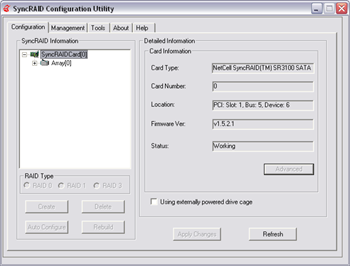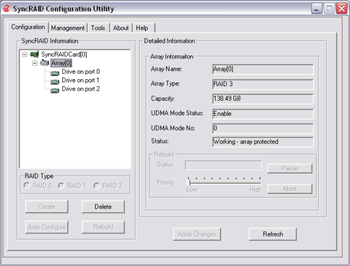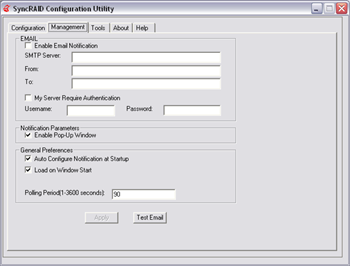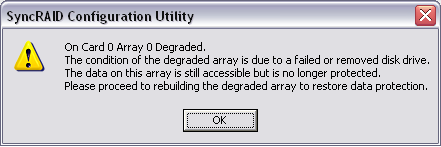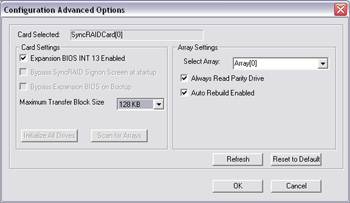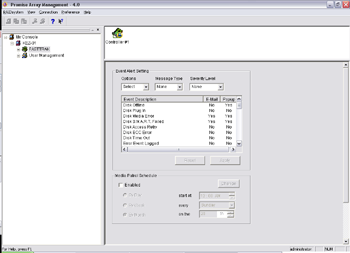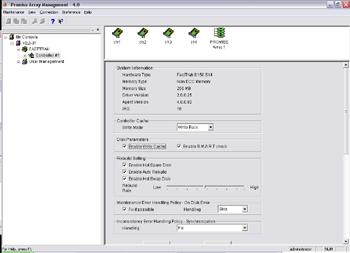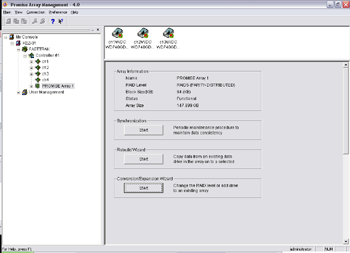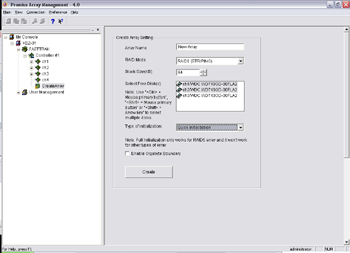Software
Having braved the depths of the mystical RAID BIOSes, it's time to get a little more graphical.
Revo 64 SyncRAID Configuration Utility
Install the SyncRAID utility and a small icon will sit in your system tray, changing colour to reflect the status of your RAID array. Double click it and the utility presents itself in its full glory.
The SyncRAID utility is clearly presented, breaking the RAID subsystem down into a tree of arrays and disks. Arrays and disks can be selected to present the information you'd expect, like array status and disk model numbers.
In the above image you can see details of the RAID 3 array that has been created. Note that you can delete the array through this utility and create a new one. Greyed out on the right of the window is a slider used to determine the priority of an array rebuild operation. If a disk is lost from the array, it will need to be rebuilt once it is replaced. This slider allows you to choose whether to get the array fully rebuilt as soon as possible, or whether to give more priority to applications requesting data from the array. However, you can only change it while a rebuild is in progress.
When things go awry, you can have SyncRAID e-mail you or display pop-up messages. However, if you want the array to automatically rebuild itself when a replacement for a failed disk becomes available, you'll need to go into the advanced settings and tick the "auto rebuild" box, seen below.
Finally, should an updated firmware become availble for the card, the SyncRAID software includes the facility for creating a boot disk from which the firmware can be updated.
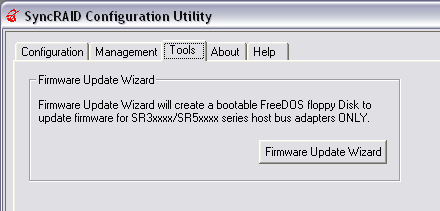
Promise Array Management
The management software for the FastTrack SX4, on first sight at least, seems more sophisticated. The layout of the array is very similar to that of the Windows Computer Management console.
As with the SyncRAID utility, you can configure alerts and e-mails when certain events occur.
Again, auto rebuild and rebuild speed options are available, along with hot spare support and the status of the array. There are also options for error handling and how the onboard cache is used. In write back mode, data to be written to the array can be offloaded to the cache and then written to disk, improving performance. However, a power failure in this configuration can result in loss of data.
On a scheduled basis or at the user's discretion, the array management software can synchronise the array, verifying that the parity data matches up with the data it is there to protect.
Creating an array is extremly easy. You'll see in the above screenshot the option to enable "Gigabyte boundary". The idea behind this is that a failed disk drive can be replaced by one that isn't identical (i.e. it is slighly smaller, possibly due to being made by a different manufacuturer of being a newer model with different platter densities.) This does mean that the overall size of the array is slightly smaller. You can also upgrade existing arrays through Promise Array Management, for example, taking a 2 disk RAID 0 array, adding in a third disk and upgrading it to RAID 5. Or, you may simply want to expand the 2 disk RAID 0 array into a 3 disk RAID 0 array.
Software Thoughts
Promise, with their array management software, have an interface that would probably make a system admin feel quite at home. Incidentally, remote management of arrays over a network is supported by the software. It's here where again, we see that the FastTrack card is more server-oriented, in some ways at least.
The SyncRAID software for the Revo 64 is very user friendly, and while it doesn't have quite as many advanced features as Promise's array management, it provides an easy means of creating, managing and monitoring arrays.






